
On OCTOBER 13, 2022
5 Effortless Steps to Create A Killing Buyer Journey Map
Nothing can ensure the triumph of your marketing campaigns or the growth of your business. Thus, to develop your brand, one of the most vital actions to take is to deeply understand your target customer and create a meticulous buyer journey map.
Valid customer journey maps are undoubtedly an ace up your sleeve to help you to draw up killing business development strategies and build a thriving brand.
In this article, Smart Tribune will get you covered with:
- Definition of a buyer journey map
- Techniques to create impeccable buyer journey maps
- Benefits of buyer journey mapping
- Common types of customer journey maps
- What to include in a buyer journey map?
- FAQs about buyer journey map
If you're pumped and so we are, let's get the ball rolling!
What is A Buyer Journey Map?
Before delving into the buyer journey map, let's find out the answer to "what is the buyer's journey?"
What is the buyer's journey?
The buyer's journey or customer journey illustrates exactly the whole buying process that your prospects go through. Normally, there are 3 stages of the standard buyer's journey, which are
- Awareness stage: The customer is aware of his issue.
- Consideration stage: The customer attempts to find available solutions.
- Action stage: After seriously considering, the customer makes up his mind on the suitable provider.
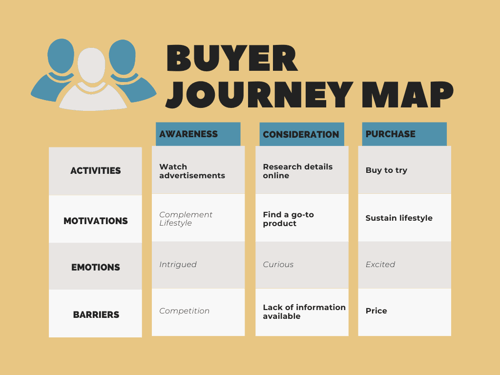
Above is a broad picture of a buyer's journey. Now, let's dig a little deeper into a buyer journey map.
What is a buyer journey map?
A buyer journey map or customer journey map or user journey map is a diagram that depicts your target customer's possible thoughts, emotions and actions throughout the purchasing process.
Thanks to an elaborate buyer journey map, a business owner can better understand his prospects’ needs to provide them with related content or materials and greatly enhance their experience. The effective engagement of a business in every customer's touchpoint can lead to higher conversion and customer retention rates as the merchant can offer everything that a would-be customer expects.
For example, in the awareness stage, your customer recognises his "pain" and may post several questions in mind, such as "Why does my phone battery drain fast?"
In this phase, the potential customer may feel worried and thirsty for information. If you are a mobile phone provider, you should compose some articles covering the list of symptoms of a bad cell phone battery, how to check phone battery health, or how to improve phone battery lifespan to ease your customer's pain immediately.
With this valuable information, prospects will regard you as an expert in the field and keep following your articles. This is the very first step to gradually imprinting your brand on your prospective customers' minds and converting them to the next phase of the buyer journey.
How to Create a Buyer Journey Map?
The client journey mapping process might be slightly tricky if you have never done it before. No worries! In the next 10 minutes, we will be providing you with 6 easy steps to successfully create buyer journey maps. Let's get cracking!
Set specific goals for your customer journey map
Your customer journey map will be useless if it has no role to play. So, before mapping customer journey, ask yourself several questions regarding the purpose of the map and what you expect from the map.
Understand your target customer
The more meticulous your customer demographic is, the more easily you can approach them.
With deep insights into your target customers, you can tailor your marketing techniques to make your advertisement or your content as helpful yet appealing as possible.
Research your customer personas
After listing out your target customers, you should start digging into customer personas.
A customer persona is an archetype of your ideal customers. Customer personas depict behavioural patterns, occupation, characteristics and so on.
Customer personas give you a better understanding of your target customer and help you brainstorm decent campaigns for each group of clientele.
By centering your customers, you can fulfil their demands in a more efficient way.
It comes as no surprise that a business has more than one customer persona. Accordingly, it is critical to map the customer journey separately for each demographic.
List out every customer touchpoint
Touchpoints are anytime, anywhere that your customers can connect and interact with your brand. It might be your customer reading the blog posts or reaching out to the customer service team and the like.
In order to have a broader picture of the customer touchpoints, check out our The Ins and Outs of Customer Journey Touchpoints article.
Listing out all of the available touchpoints is of paramount importance in generating a buyer journey map. A brand can uplift the customer experience by thoroughly researching each touchpoint and filling out the room for improvement.
This ensures that you know the user medium and what audiences of each source expect from your brand. Modifying content based on the target audience on diverse channels is definitely the key to success as you are delighting them with personalised messages.
Check out the list of touchpoints below to make sure you don't miss any potential moment or channel to drive a prospect to a customer.
|
Buyer Journey Stage |
Possible Touchpoints |
|
Awareness |
|
|
Consideration |
|
|
Action |
|
|
Retention |
|
|
Advocacy |
|
Besides, if a customer is inquiring about your business information, deploying a chatbot is a must to diminish waiting time and boost customer experience.
Book a demo to see how a customer self-service website revs your revenue.
Wondering why a chatbot can do wonders to your website, discover more:
- What is A Chatbot?
- Top 9 Practices of Lead Generation Chatbot That Hit The Mark
- 5 Reasons Your Business Needs an Ecommerce Chatbot
- 7 Ways Chatbots For Sales Can Help Your Business
Adjust the buyer journey map
After dedicating time and effort to a buyer journey map, you should employ it to make any necessary changes.
The customer journey is not linear, so you can apply a dozen of customer journey maps and constantly modify them to figure out which functions properly and which doesn't.
The editing buyer journey map process also allows you to detect uncovered issues and troubleshoot them ASAP.
Continually mapping the buyer journey will eventually equip you with an intensive comprehension of your customers, hence, improving their experience.
Why is A Buyer Journey Map Important?
It's worth noting that every buyer journey map or customer journey map is drawn out to serve as a pointer on how to properly approach prospects in each buying journey phase.
As mentioned above, buyer journey mapping will arm you with target customers' traits, what they want to know and what affects their buying decision. These insights will help you to draw up winning marketing strategies, both inbound and outbound plans.
In a nutshell, everything you need to do is to figure out what your prospects do and think, and educate them to opt for your products or services in the action stage.
Benefits of Buyer Journey Mapping
Doubtlessly, mapping customer journeys will bear fruit. Let's check out what a buyer journey map brings to the table.
.png?width=600&height=396&name=FR%20blog%20infography%20(1).png)
1. Better understanding customers
Creating a buyer journey map based on both consumer psychology and collected data reinforces your customer knowledge base. With this beneficial information, designing efficacious marketing schemes is within your reach.
Imagine how wonderful it is when you can break into consumers' minds and manipulate yet satisfy them. A customer journey map will give you a leg up in nurturing your prospects.
2. Sorting out excellent touchpoints
There exist a handful of channels to invest in but not all of them produce the same satisfactory outcome.
After making buyer journey maps, a brand can re-allocate both financial and human resources to invest more in potent touchpoints.
Saving the number of marketing attempts in ineffective channels is a great way to devote more effort to effective ones. This investment will improve those touchpoints' efficiency without extra bucks.
3. Delivering compelling inbound marketing strategies
Gone are the days customers were instantly impressed by your advertisement and made up their minds to purchase your products immediately. Nowadays, implementing 100% outbound marketing strategies might be a daunting task as it is costly and somehow inefficient.
Thus, when fully understanding the target customer's traits, you and your team can refocus on inbound marketing.
Inbound marketing is a tool that helps you nurture your target customer with beneficial yet interesting content. By the same token, mapping customer journey supports you to avoid whatever turns your customer away.
Just deep dive into topics that attract your customers' attention and gradually convert them to other content. This process not only turns prospects into customers but also leads them to outspoken advocates. When considering you as an expert in the field, customers tend to purchase and recommend your products.
4. Elevating customer experience
In each touchpoint and buying process phase, a customer goes through different emotions. With a well-prepared buyer journey map, you can straightforwardly ease your customers' pains when they face difficulties.
Even if you cannot directly help your customer out, you can adopt automation technology to raise the bar for customer service. Check out the best practices for building a digital customer experience to bolster your service.
What are Types of Buyer Journey Maps?
Apparently, you can create your own buyer journey maps in any suitable format. Having said that, we will get you covered with four common types of buyer journey maps.
Similar as it seems, each meets certain business demands and has a different role to play. Keep scrolling down to locate the best suit for your business.
1. Day in the life
Its name spells out all. This type of buyer journey map demonstrates the daily routine, usual thoughts and feelings of individuals. Since this map emphasises difficulties existing in normal people's lives, your brand can exploit this customer journey map to expand a new market development strategy.
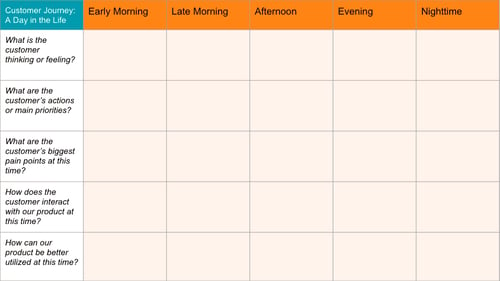
2. Current state
This is the most commonly used type of buyer journey map. This map reveals what an individual does and thinks when they interact with your products or services. The current state maps will make it easier for you to improve your customer experience as they show the existing pain points between your brand and the customers.
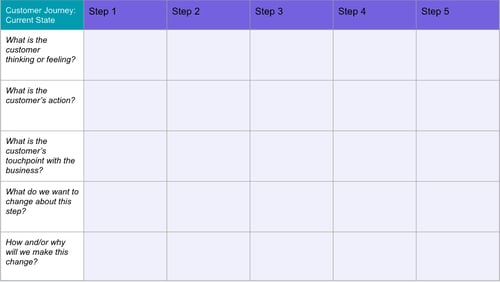
3. Future state
The future state maps highlight the possible actions and emotions of customers when they utilize your product in the future. This buyer journey map type will contribute to your growth when you desire to express your vision for a brand-new or advanced product or service.
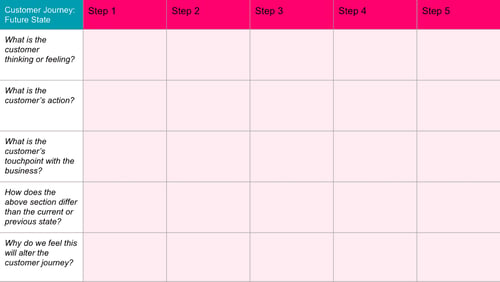
4. Blueprint
This map cannot perfectly function when being used alone. Your brand can unlock its full potential by applying it to your current state or future state maps.
Blueprint or service blueprint buyer journey map is ubiquitously used to pinpoint the causes of existing pain points of your customers. Simultaneously, if you apply this blueprint to a future state journey map, your brand will figure out what needs to be done to improve future customer experience.
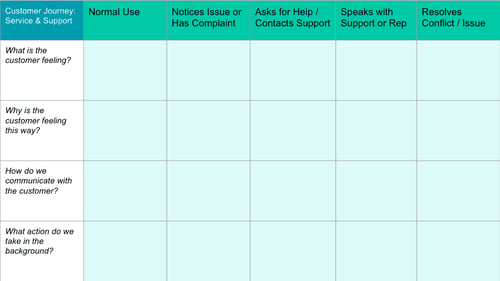
What to include in a buyer journey map?
1. The buying stage.
A standard buyer journey map must include the whole buying process to define the necessary actions to take in each phase. Simply, you can sketch out a purchasing path horizontally: Awareness, Consideration, and Action.
To go the extra mile, you can add the Retention and Advocacy phase after completing an order to provide your customer with long-term value and increase returning customers.
2. Possible buyer actions analysis.
This presumption details what your buyers do in each phase of the customer journey.
Here are some suggestions for you:
- They may ask for advice from friends and family in the awareness stage when recognising their "pain".
- In the consideration phase, prospects may make use of a free trial or compare your products with other competitors.
- Prospects will turn into customers in the action stage by purchasing your products with their credit cards.
Listing out the assumptions will assist you to imagine what your target customers do and accordingly deliver the proper content.
3. Buyer's emotions
Basically, the buying process is a process in which a customer is trying to solve a problem, so customers will express their emotions along the journey.
Comprehending your customers' thoughts and feelings will help you to determine a suitable tone of voice and the purpose of the content.
The content will play an integral role in manipulating customers' emotions and leading them to the next phase of the buyer journey map.
4. Pain points
The marketing effort will all go down the drain if you cannot identify your potential customer's pain points. With deep insights into customers' worries, you can adjust your pitch and point out why your product is the right solution.
On the other hand, being aware of customers' pain points helps you to send out appealing advertisements.
5. Solutions
Last but not least, you and your team should come up with solutions on how to streamline the buying process. A smooth buying process means a pleasant customer experience, hence, pumps up your revenue.
FAQs about Buyer Journey Map
1. What is a customer journey map?
A customer journey map or a buyer journey map or a client journey map carry the same meaning. It is a tangible depiction of the customer's pain points, normal emotions and actions. This customer journey map takes the leading role in guiding brands to take needed action to grasp customer attention and convert them.
2. What makes a good buyer journey map?
An ideal buyer journey map can help every member of the team to deeply understand the target customer. Meanwhile, it enables your business to figure out what to do to attract more customers, enhance customer experience and even develop the existing product to meet customers' needs.
3. What are the types of customer journey maps?
It is widely known that there are four types of customer journey maps, which are Current State, Future State, Day in the Life and Service Blueprint. Each is designed to serve a particular business purpose.
Final thoughts on Buyer Journey Map
By and large, a buyer journey map is a pivotal factor profoundly influencing your business development. This map is a functioning way to gather all indispensable information and data related to your potential customer. From there, your business can run various campaigns or customise marketing strategies to reach their full potential, and ultimately, skyrocket your sales.
If you are struggling with automation in some customer touchpoints, give Smart Bot, Smart FAQ, Smart Knowledge and Smart Push a shot. Smart Tribune will be part of your business's prosperity.


.png)



